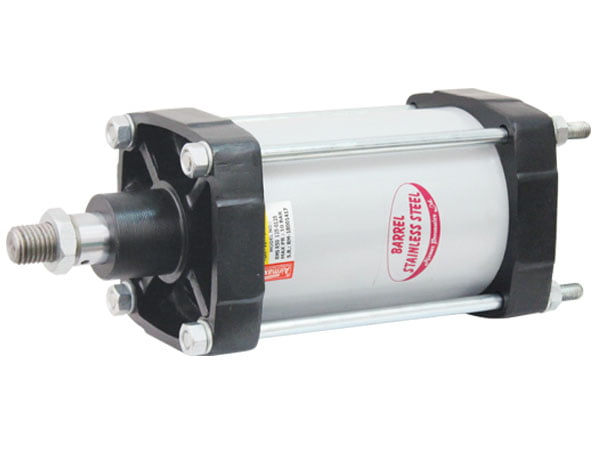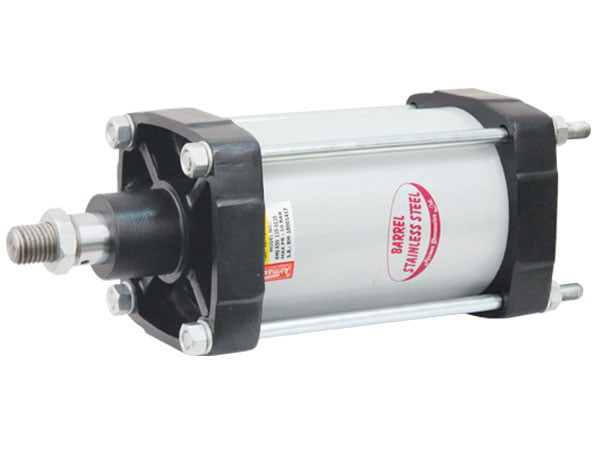Selecting the right double acting pneumatic cylinder size is a crucial step in designing efficient and effective pneumatic systems. Choosing the appropriate cylinder size ensures that your system operates optimally, delivering the required force and stroke length for your application. Here are some key considerations when selecting the size of a double acting pneumatic cylinder:
- Load Requirements: Determine the maximum load that the cylinder needs to move or control. This load, often measured in pounds or kilograms, directly impacts the cylinder size selection.
- Stroke Length: Calculate the distance the piston needs to travel to fulfill its intended function. The cylinder size must provide the necessary stroke length.
- Operating Pressure: Consider the required pressure to move the load and choose a cylinder capable of handling this pressure comfortably.
- Speed and Flow: The desired operating speed and flow rate of air through the cylinder affect size selection to ensure smooth and controlled movement.
- Safety Factors: Incorporate safety margins to account for unexpected loads or system variations.
Selecting the right double acting pneumatic cylinder size is essential to achieving optimal performance while ensuring the system operates efficiently and safely.
Determining Stroke Length and Travel Requirements
When designing a system utilizing a double-acting pneumatic cylinder, one of the critical factors to consider is the stroke length and travel requirements. The stroke length, which refers to the distance the piston travels within the cylinder, directly impacts the cylinder’s performance and the system’s overall efficiency. Here are some key points to consider:
- Application Specifics: Begin by thoroughly understanding the application for which the double-acting pneumatic cylinder will be used. Consider the tasks it needs to perform and the required motion, whether it’s pushing, pulling, lifting, or moving items horizontally.
- Maximum and Minimum Stroke: Determine the maximum and minimum stroke lengths needed for your application. This ensures that the cylinder can cover the full range of motion required without overextending or underperforming.
- Consider Safety Margins: Factor in safety margins when deciding on stroke length. Adding a bit of extra stroke can prevent potential issues caused by variations in load or unforeseen circumstances, enhancing the reliability of your system.
- Space Constraints: Evaluate the available space in your application. Ensure that the cylinder’s extended and retracted positions fit within the allotted area without causing interference with other components.
- Cycle Frequency: Assess how often the cylinder will be actuated. Frequent cycling might require a robust design and more durable materials.
Properly determining the stroke length and travel requirements for your double-acting pneumatic cylinder is crucial for achieving optimal system performance and longevity. It ensures that the cylinder operates efficiently, reliably, and safely within your specific application.
Pressure and Force Calculations for Optimal Performance
When designing systems that utilize double-acting pneumatic cylinders, understanding pressure and force calculations is paramount to ensure optimal performance. These calculations help engineers and designers determine the right cylinder specifications for their application. Here are some key considerations:
- Pressure Requirements: Calculating the required pressure involves assessing the load the cylinder will need to move and overcoming any resistance in the system. This calculation accounts for both the extension and retraction strokes of the cylinder.
- Force Calculations: Force calculations take into account the surface area of the piston within the cylinder. The formula for force (F) is F = P x A, where P represents pressure and A represents the piston area. Engineers must ensure that the calculated force meets or exceeds the load requirements.
- Balancing Act: Balancing the forces on both sides of the double-acting pneumatic cylinder is crucial for stable and efficient operation. This balance prevents unnecessary wear and tear on the cylinder components.
Proper pressure and force calculations for your double-acting pneumatic cylinder system guarantee that it operates effectively and efficiently, delivering the required performance for your application while maximizing the cylinder’s lifespan.

Choosing the Appropriate Cylinder Material and Construction
Choosing the appropriate cylinder material and construction is a critical aspect of designing a reliable and efficient double-acting pneumatic cylinder system. The choice of materials can significantly impact the cylinder’s performance, durability, and suitability for specific applications. Here are some key considerations in this regard:
- Material Selection: The material used for the cylinder body, piston, and seals should be compatible with the operating environment. Common materials include aluminum, stainless steel, and various alloys. Stainless steel, for instance, is corrosion-resistant and ideal for harsh environments.
- Heat Resistance: In applications where temperature fluctuations are significant, selecting materials with high-temperature resistance is crucial. This prevents deformation and ensures consistent performance.
- Seal Materials: The seals used in the cylinder play a vital role in preventing air leaks. Nitrile, polyurethane, and PTFE are commonly used seal materials, each with its own advantages in terms of temperature resistance and durability.
- Coatings: Some applications may require specialized coatings to enhance wear resistance or reduce friction. Chrome plating, for example, can increase the longevity of cylinder rods.
- Construction Type: Decide between tie-rod, welded, or extruded cylinder construction based on the system’s load-bearing requirements and overall design.
- Specialized Features: Consider additional features such as cushioning options for smoother operation or magnetic pistons for position sensing.
When choosing materials and construction for your double-acting pneumatic cylinder system, it’s essential to factor in the specific demands of your application to ensure optimal performance and longevity. The right choices will enhance the efficiency and reliability of your double-acting pneumatic cylinder system.
Mounting Options and Considerations for Cylinder Installation
When integrating a double acting pneumatic cylinder into your system, proper mounting is crucial for ensuring efficient operation and longevity. The mounting process involves several critical considerations:
- Orientation: Pay attention to the orientation of the cylinder. Ensure that it is aligned correctly to prevent binding or excessive wear.
- Rigidity: Choose a mounting arrangement that provides sufficient rigidity to handle the forces generated during cylinder operation. This minimizes the risk of misalignment or structural damage.
- Alignment: Precise alignment is essential. Misalignment can lead to uneven wear, decreased performance, and potential damage to the cylinder and associated components.
- Fastening: Select appropriate fasteners and ensure they are tightened to the manufacturer’s specifications to maintain the integrity of the mounting arrangement.
- Support: Consider the need for additional support structures or brackets to stabilize the cylinder, especially in applications with heavy loads or high forces.
- Accessibility: Plan for accessibility when mounting the cylinder for maintenance purposes. Easy access facilitates inspection and servicing.
Proper mounting of a double acting pneumatic cylinder is critical for maximizing its efficiency and lifespan, ensuring smooth operation and reducing the risk of premature wear or failure.
Integration of Double Acting Cylinders into Control Systems
In the realm of industrial automation, the seamless integration of double acting pneumatic cylinders into control systems is pivotal for achieving precise and efficient motion control. These cylinders play a vital role in pushing, pulling, lifting, and holding tasks across various industries, and their integration demands careful planning and consideration.
- Sensor Technology: Incorporating sensors like position sensors or proximity switches helps monitor the cylinder’s position. These sensors send feedback to the control system, ensuring precise positioning and control.
- Control Logic: Developing a robust control logic is essential. It dictates when and how the double acting cylinder should actuate. This logic can be programmed into a programmable logic controller (PLC) or a microcontroller, depending on the complexity of the application.
- Communication Protocols: Choosing the right communication protocol (e.g., Modbus, CAN, or Ethernet) ensures seamless data exchange between the control system and the double acting pneumatic cylinder, allowing for real-time adjustments and feedback.
- Safety Measures: Implementing safety features, such as emergency stops and limit switches, enhances the overall safety of the system.
- Integration Testing: Rigorous testing and validation are crucial to ensure that the double acting cylinder operates as intended within the control system.
Integrating double acting pneumatic cylinders into control systems enhances productivity, accuracy, and safety in a wide range of applications. Proper integration ensures that these cylinders function harmoniously within the larger industrial automation framework, providing the precision and reliability required for modern manufacturing processes.
Safety Measures in Designing Pneumatic Cylinder Systems
Designing pneumatic cylinder systems, particularly those utilizing double acting pneumatic cylinders, necessitates a keen focus on safety. Implementing robust safety measures is paramount to ensure the well-being of personnel and the longevity of equipment. Here are key considerations:
- Risk Assessment: Begin by identifying potential hazards and risks associated with the pneumatic cylinder system’s operation.
- Proper Mounting: Ensure secure and stable mounting of the cylinder to prevent unexpected movement.
- Pressure Relief Valves: Install pressure relief valves to protect against over-pressurization and potential explosions.
- Emergency Stop Mechanisms: Implement emergency stop mechanisms that can swiftly halt the system in case of emergencies.
- Valve Lockouts: Use valve lockout devices to prevent unintentional actuation during maintenance or repair.
- Regular Maintenance: Establish a maintenance schedule for inspecting and maintaining cylinders to catch wear and tear early.
- Training: Provide comprehensive training for personnel operating and maintaining the system to minimize accidents.
- Safety Labels: Clearly label potential hazards and safety instructions on the system.
- Emergency Procedures: Develop and communicate emergency procedures to respond to cylinder failures or malfunctions.
- Material Selection: Choose materials that can withstand the system’s pressure and environmental conditions.
By adhering to these safety measures during the design phase of double acting pneumatic cylinder systems, you can significantly reduce the likelihood of accidents and ensure the system’s reliable operation.


